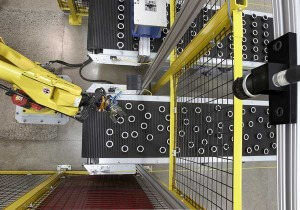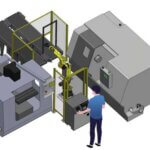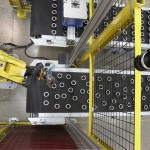Benefits of Automation in Manufacturing
Productivity knows that when it comes to manufacturing, change can seem overwhelming, time-consuming and scary — to say the least. While not all change is created equal, many shops resist changing to automation for a number of reasons. The good news is that it doesn’t have to be that way, and automation integration shouldn’t keep you up at night nor should workers fear being replaced. In fact, you’ll be surprised by the number of productive hours you’ll gain and new projects and business you’ll be able to take on with automation. The best place to start is with Productivity’s applications and automation experts who are committed to helping companies implement innovative automation solutions that meet manufacturing challenges. They’ll guide you through the process of your robotics integration projects from start to finish. Whether you’re adding one or many robots, automating your turning production processes with bar feeders, automatic pallet loaders (APLs), or using vending systems to automate control of tooling and accessories, this guide will demonstrate the multitude of benefits of automation and help you make the best decision for your manufacturing facility.
replaced. In fact, you’ll be surprised by the number of productive hours you’ll gain and new projects and business you’ll be able to take on with automation. The best place to start is with Productivity’s applications and automation experts who are committed to helping companies implement innovative automation solutions that meet manufacturing challenges. They’ll guide you through the process of your robotics integration projects from start to finish. Whether you’re adding one or many robots, automating your turning production processes with bar feeders, automatic pallet loaders (APLs), or using vending systems to automate control of tooling and accessories, this guide will demonstrate the multitude of benefits of automation and help you make the best decision for your manufacturing facility.
What is the purpose of automation?
With the push for Just-In-Time (JIT) manufacturing and the importance of reaching higher productivity and efficiency levels, automation in manufacturing is paramount. Over the decades, automation has become a standardized production tool empowering manufacturers to gain better control of their operations and production processes. With automation’s ability to streamline repetitive, hazardous, and tedious tasks, an automated system can perform load/unload tasks, processing, inspection, assembling or handling of parts unattended or lights out, allowing one employee to work on several machines or other jobs at the same time.
Automation in manufacturing can help lower costs, improve worker safety, reduce factory lead times, provide faster ROI, allow your operation to become more competitive, increase production output, and so much more!
Explore the benefits of automation in detail with this guide. You can also check out Productivity’s Robotics & Automation Services.
Advantages of Automation in Manufacturing
What is the biggest impact of automation?
1. Lowered operating costs
Robots can perform the work of three to five people, depending on the task. And bar feeders and APLs allow your machinists to attend to multiple machines at once. In addition to savings on the cost of labor, energy savings can also be significant due to lower heating requirements in automated operations. Automation integration streamlines processes and increases part accuracy, which means minimal material waste for your operation.
Other Important Benefits of Automation
 2. Improved worker safety
2. Improved worker safety
Automated cells, bar feeders and APLs remove workers from dangerous tasks. Your employees will thank you for safeguarding them against the hazards of a factory environment.
3. Reduced factory lead times
Automation can keep your process in-house, improve process control and significantly reduce lead times compared to outsourcing or going overseas.
4. Faster ROI
Automation solutions are based on your unique needs and goals and pay for themselves quickly due to lower operating costs, reduced lead times, increased output and more.
5. Ability to be more competitive
Automated cells, bar feeders and APLs allow you to decrease cycle times and cost-per-piece while improving quality. This allows you to better compete on a global scale. Additionally, the flexibility of automation integration enables you to retool a cell to exceed the capabilities of your competition.
 6. Increased production output
6. Increased production output
A robot has the ability to work at a constant speed, unattended, 24/7, as do bar feeders and APLs. Automation in manufacturing means you’ve got the potential to produce more. New products can be quickly introduced into the production process and new product programming can be done offline with no disruption to existing processes.
7. Consistent and improved part production and quality
Automated cells, bar feeders and APLs typically perform the manufacturing process with better consistency than human machinists. This results in greater control and consistency of product quality.
8. Smaller environmental footprint
By streamlining equipment and processes, reducing scrap and using less space, automation uses less energy. A key benefit of automation is that it reduces your environmental footprint which can save you real money.
9. Better planning
Consistent production by automation integration allows a shop to reliably predict timing and costs. That predictability permits a tighter margin on almost any project.
10. Reduced need for outsourcing
Automated cells have large amounts of potential capacity concentrated in one compact system. This allows shops to produce parts in-house that have previously been outsourced.
11. Optimal utilization of floor space
Robots are designed on compact bases to fit in confined spaces. In addition to being mounted on the floor, robots can be mounted on walls, ceilings, rail tracks and shelves. They can perform tasks in confined spaces, saving you valuable floor space.
12. Easy integration
Productivity will work with you to provide a complete robotics solution system — hardware, software and controls. Your cell will be proven out at Productivity and shipped out production-ready — allowing you to start making parts as soon as it’s installed in your shop.
13. Maximized labor
Over the next three decades, statistics show that more than 76 million baby boomers will retire and only 46 million new workers will be available to replace them. During this time, your demand for labor will continue, making automation a real and viable solution.
14. Increased productivity and efficiency
- 24/7 production, JIT manufacturing-friendly
- More uptime with historic efficiency figures above 90 percent
- Secondary operations capability — gauging, washing, deburring, etc.
- Real-time factory communications with automated cells and machines
- Quick changeover for multiple parts, tooling and programs
- Flexible multi-operations capability — Op 10, Op 20, etc.
15. Increased system versatility
- System flexibility, easily retooled and repositioned for new production programs
- Robots, bar feeders and APLs are flexible and can easily be redeployed in new applications or parts
- Robots, bar feeders and APLs have the ability to easily switch between a wide range of products without having to completely rebuild production lines
- Quick changeover with auto grippers and vision allows for different part sizes and shapes to be part of the same run
- Mixed-flow production approach allows for flexibility in adjusting to demand fluctuations
- Robots are able to instantaneously “learn” new processes
- Reduced changeover time
Download our new Benefits of Automation PDF.
Interested in automation for your manufacturing? We can help. Contact us today!